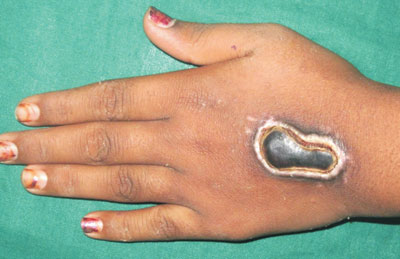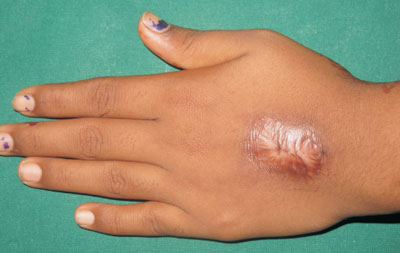An 11-year-old girl, suffering from Dengue fever, developed
pain and swelling in the dorsum of left hand following
intravenous Ceftriaxone. The swelling resolved over 8 days
and the affected area turned reddish violet and eventually
black over next 20 days. On cutaneous examination, a single
necrotic eschar 5◊7 cm with a surrounding tough, fibrotic
margin was present on the dorsum of the left hand (Fig.
1). On the basis of history and clinical features, we
diagnosed Nicolauís Syndrome. Debridement of the area of
necrosis was done along with oral antibiotics. Her wound
healed in three weeks (Fig. 2).
 |
 |
|
Fig. 1 Necrotic eschar on
dorsum of left hand.
|
Fig. 2 Healed lesions after
3 weeks.
|
Nicolauís Syndrome Ė also known as
Embolia Cutis Medicamentosa Ė is a rare, cutaneous, adverse
complication of drug administration. Inflammation, embolism,
thrombosis and vasospasm are the various mechanisms
proposed. Direct or indirect vessel damage involving any or
all these mechanisms ultimately leads to peripheral arterial
occlusion. Differentials to be considered are acute
compartment syndrome (severe pain, pallor, swelling,
paresthesia and poikilothermia), subcutaneous fat necrosis
(seen exclusively in newborns), and gangrene (distally
located). Prevention is by taking care to avoid accidental
intra-arterial or para-arterial injection or injection of
the drug into an arteriole. Debridement is the mainstay of
therapy.

